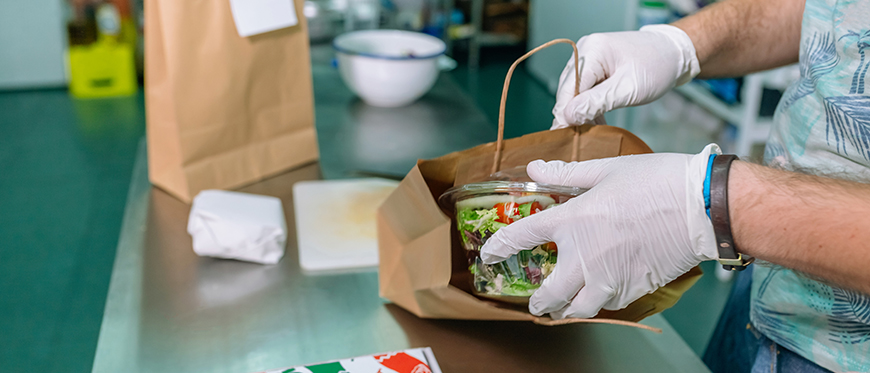Prior to the pandemic, we started to see a shift in consumers’ preference for off-premise dinning. Food delivery and takeout spiked significantly during the pandemic as customers and the industry adjusted to a new reality of safety and hygiene concerns. Changing circumstances have led to new opportunities in the industry, such as the explosive growth of ghost kitchens to service that increased delivery demand. With promises of optimized and expanded delivery service at minimal cost, ghost kitchens may even become a $1T global market by 2030.1 But what are ghost kitchens? And what could they mean for your restaurant?
What is a ghost kitchen?
A ghost kitchen is a professional food preparation and cooking facility set up to serve delivery and takeout orders exclusively. They include all of the kitchen equipment needed to prepare meals but have no eat-in or customer-facing areas. They’ve grown so quickly that the industry uses many names for them: cloud kitchens, dark kitchens, or shared kitchens.
Ghost kitchens are a different concept from virtual restaurants, however. A virtual restaurant is a food service business that serves customers exclusively by delivery based on phone orders or online food ordering. It is a separate food vendor entity that operates out of an existing restaurant’s kitchen. It contrasts with a ghost kitchen, which is a co-working concept for meal preparation with no retail presence that a restaurant/brand or multiple restaurants can buy into. Like ghost kitchens, they do not offer on-premise dining. A ghost kitchen is not a restaurant brand itself. It is simply a food preparation area other brands can use. In fact, most ghost kitchens produce meals for multiple brands.
Watch a ghost kitchen in Chicago, IL in action.
Are you interested in going ghost? Learn about some of the opportunities and challenges that this new kitchen model entails below.
Ghost kitchen opportunities
Ghost kitchens are growing more popular with operators because food delivery is exploding, and many industry experts anticipate the future of food lies in delivery. Looking at the benefits of ghost kitchens for operators, it’s clear why the growth has been so dramatic.
- Lower costs: Front-of-house labor, investments in expensive real estate, equipment and more aren’t required.
- Fast expansion: New businesses can take advantage of turnkey facilities to launch a new concept or new location in as little as one month.
- Low-risk experimentation: Ghost kitchens can be used to launch an entirely new business or food concept without committing to permanent locations or heavily customized food trucks.
- Focused on food: Utilities, maintenance, security, legal and other overhead is already taken care of or shared among ghost kitchen users leaving operators to focus on cooking and quality.
- Optimized for delivery: From food packaging and pick-up queues for delivery companies to more ideal locations near customers, all aspects of ghost kitchens are optimized for more efficient deliveries.
Ghost kitchen challenges
While there are many positives that come with ghost kitchens, some drawbacks do exist.
- No walk-in traffic: Can be difficult to build a fanbase without the benefit of walk-in traffic or solely by paying for online visibility.
- Geography constraints: A single location typically can serve only a 3- to 5-mile delivery radius.
- On-demand staff: Can be difficult to attract top foodservice talent and build a consistent brand culture without committing to permanent employees.
- Reliance on third-party deliveries: Competition and advertising costs continue to increase within the online and in-app delivery marketplace making it hard to stand out—or even get started building a loyal following. Ghost kitchen operators also have little control over the quality of last-mile deliveries which can affect their reputations.
- No brand boost from store front: Physical locations, particularly in well-traveled or dense population areas, serve as a constant reminder to customers.
- Food safety: Food production is mostly regulated by local health departments which may not be familiar with the concept of ghost kitchens. You may be surprised with unusual requirements.
- Food quality: Maintaining food quality and proper temperatures during the miles and minutes of the delivery process has long been challenging for restaurants—and can lead to poor customer experiences with soggy lukewarm food.
Real examples of ghost kitchens
NRD Capital, the private-equity firm that owns Ruby Tuesday, leases out kitchen space in its existing restaurants to third-party brands looking to expand their delivery footprint. Wow Bao, a fast-casual chain that sells dumplings and steamed buns, rents kitchen space and labor from a variety of existing restaurants to service far more customers. Other companies, such Kitchen United and Cloud Kitchens, have no menus of their own and solely exist to provide turnkey ghost kitchen facilities to other brands.
With more food delivery growth anticipated in the coming years, ghost kitchens are likely to continue expanding as well. With 52% of global consumers already feeling comfortable ordering from a delivery-only restaurant with no physical storefront,3 look for these numbers to increase too as customers get more familiar and comfortable with ghost kitchens.
If you’re interested in opening or using a ghost kitchen and seek hygiene tips to ensure you’re operating safely and hygienically, download the new Tork on-the-go hygiene guide.
Sources:
1 The Spoon: Euromonitor: Ghost Kitchens Poised to Become a $1T Market by 2030
2 Restaurant Business: Behind the scenes at a Ghost Kitchen in Chicago
3 Euromonitor: Ghost Kitchens: Food Delivery Amid Lockdown
